Helicopter taking off
This one is for Ollie:
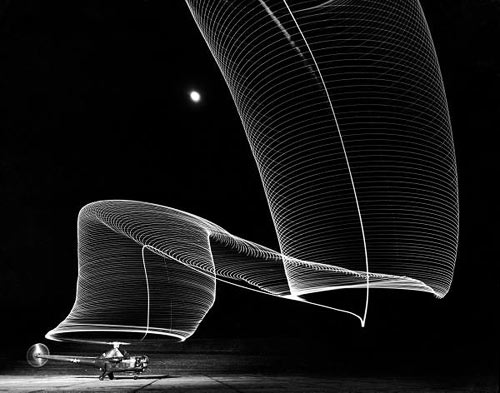
(via today and tomorrow)



This site is made possible by member support. 💞
Big thanks to Arcustech for hosting the site and offering amazing tech support.
When you buy through links on kottke.org, I may earn an affiliate commission. Thanks for supporting the site!
kottke.org. home of fine hypertext products since 1998.
Adam Lisagor notices that the iPhone 3GS camera might always be buffering images so that when you press that shutter button, you get the photo that you wanted, not the one delayed by slow software or a slow shutter. Adam’s observation gives me the opportunity to trot out one of my recent favorite informational factoids about the super high-speed cameras used to capture jumping great white sharks:
In order to get the jaw-dropping slow-motion footage of great white sharks jumping out of the ocean, the filmmakers for Planet Earth used a high-speed camera with continuous buffering…that is, the camera only kept a few seconds of video at a time and dumped the rest. When the shark jumped, the cameraman would push a button to save the buffer.
An assessment: what sort of photographer is the Google Street View car?
Initially, I was attracted to the noisy amateur aesthetic of the raw images. Street Views evoked an urgency I felt was present in earlier street photography. With its supposedly neutral gaze, the Street View photography had a spontaneous quality unspoiled by the sensitivities or agendas of a human photographer. It was tempting to see the images as a neutral and privileged representation of reality — as though the Street Views, wrenched from any social context other than geospatial contiguity, were able to perform true docu-photography, capturing fragments of reality stripped of all cultural intentions.
Tired of retouched women in magazines looking like “objects from Mars”, photographer Peter Lindbergh captured eight models without makeup or excessive retouching for Harper’s Bazaar’s September issue. (via fashionologie)
The Morning News has an interview with Chad States about his series of photographs of Men at Their Most Masculine. Some of the photos are NSFW.
I found all my subjects through Craigslist. I began by asking the question “Are you masculine?” in the heading. In the body of the posting I talked briefly about the project. Much to the effect of: “I am doing a photography project on masculinity. If you identify as being masculine, please get back to me.”
Masculinity seems to involve a lot of shirtlessness (and pantslessness). This one is kind of amazing.
“I am masculine because I abandon women after taking their love. Because when you study Freud, you don’t let him study you. Because I study philosophy, not literature.”
More of States’ masculinity photos can be found on his web site.
I love JK Keller’s Tatamount project.
Photographs of mountains are computationally altered to flatten the mountain’s elevations, while an ocean horizon is altered to mimic the mountain’s original topography.
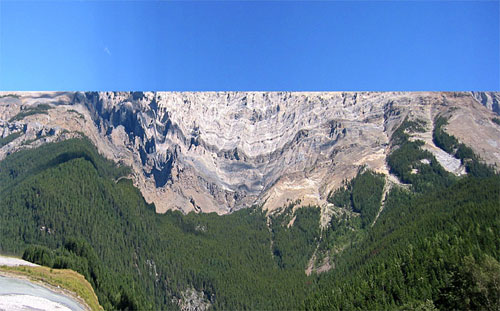
In the comments, he mentions that the effect is done with a combination of JavaScript and Photoshop…which I didn’t even know was a thing. (via today and tomorrow)
In remembrance of the mass destruction of life and property due to the dropping of the first atomic bomb on Hiroshima 64 years ago today, The Big Picture presents a typically excellent selection of photos.
Update: From Design Observer about a year ago, Hiroshima, The Lost Photographs.
Man and nature conspire to create something that looks straight out of a Pixar film.

Worth viewing large. (via flickr blog)
In early July, a photographer took a picture of what appears to be three Suns rising over Gdansk Bay in Poland.

The photographer insists that the effect was not created by the camera and was visible to the naked eye. The early consensus in the forums is that the photo was taken through a double-paned window.

High Glitz is Susan Anderson’s portrait series depicting “the extravagant world of child beauty pageants”.
Hours of preparation are spent on each child’s appearance, and her camera records it all in graphic detail. Children’s pageants are a fascinating subculture, but more than anything they represent a strange microcosm of America itself. Our own values of beauty, success and glamour reflected in the dreams of thousands of young girls…
Sweet Jesus, I’m gonna have some nightmares tonight. Can’t sleep, clown’ll eat me, can’t sleep, clown’ll eat me… (via conscientious)
Update: Colby Katz has done a similar project. (thx, chris)
A pair of photographers have photographed all sorts of different yogurt containers in the style of Bernd and Hilla Becher’s typologies.
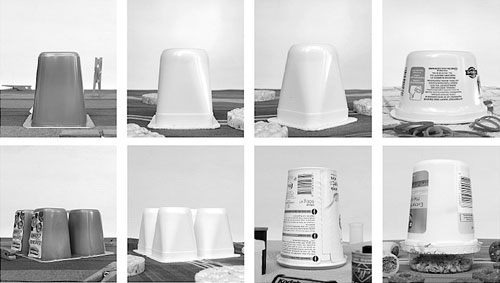
Photographer Jill Krementz has some nice photos up in remembrance of Walter Cronkite. I love the ones of him playing his daily tennis match with Andy Rooney.
Update: Esquire reprinted a 2006 interview with Cronkite.
I grew my mustache when I was nineteen in order to look older. I never shaved it off even though it overran its usefulness many, many years ago. Once you get started in television, people associate you with your physical appearance — and that includes the mustache. So I can’t shave it off now. If I did, I’d have to answer too much mail.
Yesterday was the 40th anniversary of the launch of Apollo 11 and Monday is the same for both the first Moon landing and the first walk on the surface. In this entry, I’ve collected some of the best resources on the web related to the anniversary…articles, historical documents, audio, video, transcripts, photos, and the like. Enjoy.
We Choose the Moon is tracking the activities of the Apollo 11 mission as it happened 40 years ago. Very nicely done.
Housed on NASA’s history site is a ton of resources about the Apollo 11 landing, including an annotated transript of the landing, which makes for really interesting reading. MP3 files are also available as are many, many video clips of the landing at the astronauts’ time on the surface. Highlights: this video was shot out of the window of the lunar module from a height of 50,000 feet until one minute after touchdown and I’ve never seen Armstrong’s first step on the Moon from this angle before.
For its July 21, 1969 issue, The NY Times used 96 pt. type to declare that MEN WALK ON MOON.
The landing was made four miles west of the aiming point, but well within the designated area. An apparent error in some data fed into the craft’s guidance computer from the earth was said to have accounted for the discrepancy.
Suddenly the astronauts were startled to see that the computer was guiding them toward a possibly disastrous touchdown in a boulder-filled crater about the size of a football field.
Mr. Armstrong grabbed manual control of the vehicle and guided it safely over the crater to a smoother spot, the rocket engine stirring a cloud of moon dust during the final seconds of descent.
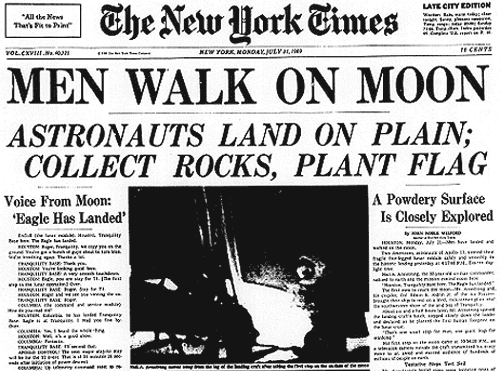
The Onion used larger type and took a more unadulterated and profane approach (love the video version).
John Noble Wilford, the Times journalist who wrote the front page story underneath the 96 pt. type — “the biggest single story of my career” — recounts his Apollo 11 experience and ponders the Apollo program’s legacy in a great piece for the Times.
It then occurs to me that if Columbus and Capt. James Cook were alive, they might be less astonished by two men landing on the Moon than by the millions of people, worldwide, watching every step of the walk as it happens. Exploring is old, but instantaneous telecommunications is new and marvelous.
In just 1.3 seconds, the time it takes for radio waves to travel the 238,000 miles from Moon to Earth, each step by Armstrong and Aldrin is seen, and their voices heard, throughout the world they have for the time being left behind. In contrast to exploration’s previous landfalls, the whole world shares in this moment.
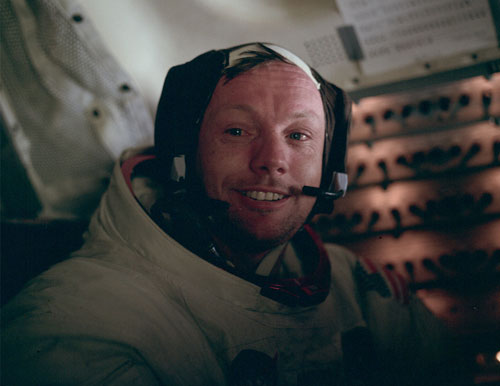
The Apollo 11 mission in photographs: NASA Images is the comprehensive source for NASA photos of the Apollo 11 mission; the always excellent Big Picture has photos of the mission from a variety of sources; David Burnett shot photos of people watching the launch; Time looks at Apollo astronauts Now and Then; the NY Times collected photos from readers of their Apollo 11 moments; Life has several photo galleries: Buzz Aldrin Looks Back, Scenes From the Moon, Up Close With Apollo 11 (rare and never-published photos), and The World Watches; and Google’s archive of Life magazine’s Apollo 11 images.
A map of where Armstrong and Aldrin walked during their 2+ hours on the surface. That same map superimposed on a soccer pitch and on a baseball field. They didn’t walk that far at all.
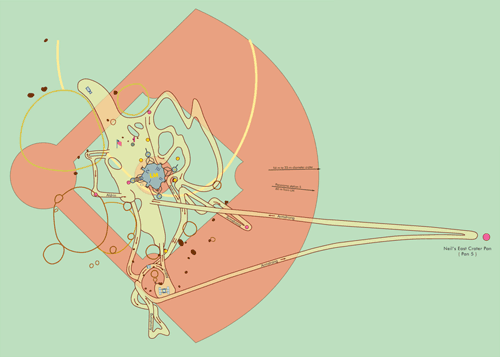
Explore the Apollo 11 landing site on Google Moon.
In piece published on the 40th anniversary of the Apollo 11 launch, Buzz Aldrin advocates not a return to the Moon but a mission to Mars with the objective of establishing a colony on the red planet.
Let the lunar surface be the ultimate global commons while we focus on more distant and sustainable goals to revitalize our space program. Our next generation must think boldly in terms of a goal for the space program: Mars for America’s future. I am not suggesting a few visits to plant flags and do photo ops but a journey to make the first homestead in space: an American colony on a new world.
Robotic exploration of Mars has yielded tantalizing clues about what was once a water-soaked planet. Deep beneath the soils of Mars may lie trapped frozen water, possibly with traces of still-extant primitive life forms. Climate change on a vast scale has reshaped Mars. With Earth in the throes of its own climate evolution, human outposts on Mars could be a virtual laboratory to study these vast planetary changes. And the best way to study Mars is with the two hands, eyes and ears of a geologist, first at a moon orbiting Mars and then on the Red Planet’s surface.
Video of John F. Kennedy’s “we choose to go to the Moon” speech given at Rice University on September 12, 1962. Fewer than 7 years later, Apollo 11 achieved the goal that Kennedy laid out in that speech.
In a piece for New Scientist, Linda Geddes writes about possible future lunar parks and how they might be preserved.
Around these [landing sites] are scattered smaller artefacts and personal items, such as Neil Armstrong’s boots and portable life-support system, scientific instruments and their power generators — and, of course, the iconic US flag which remains planted in the moon’s surface. Then there are the footprints and rover tread paths. Despite the passing of the years, these remain carved into the dust because the moon has no wind or rain to wash them away.
Anthropologist P. J. Capelotti of Penn State University in Abington has mapped out five “lunar parks”. These cover the areas where the majority of the artefacts are concentrated and could be used as a basis for future preservation efforts. “Nobody’s saying that the whole moon has to be off limits, but as people are starting to make plans for tourism and mineral extraction, or for putting a base there, they just need to be aware of them and work around them.”
Since returning from the Moon, Neil Armstrong has been less and less willing to speak in public about his Apollo 11 experience. For the 40th anniversary, Armstrong will not take part in the NASA event to commemorate the landing. His only appearance related to the anniversary will be a 15-minute lecture at a Smithsonian Institution event on Sunday night. I found this event on the National Air and Space Museum site…maybe that’s it? If so, then Armstrong’s lecture will be webcast live on the NASA TV site that evening.
Popular Science shares a list of ten things you didn’t know about the Apollo 11 Moon landing.
7. When Buzz Aldrin joined Armstrong on the surface, he had to make sure not to lock the Eagle’s door because there was no outer handle.
Moonwalk One is a documentary film about Apollo released in 1970 to little fanfare, even though it won an award at the Cannes Film Festival. The film was commissioned by NASA but with so much Apollo activity and information happening in the late 60s and early 70s, no one was interested in distributing or seeing the film and it was soon forgotten. Recently, the only remaining 35mm print of the film was located under the director’s desk, restored, and offered for sale on DVD in time for the 40th anniversary.
To get a feel of what it was like in the Soviet Union during the Apollo 11 mission, Scientific American interviewed Sergei Khrushchev, son of former Russian premier Nikita Khrushchev. The reaction was somewhat more subdued than in other parts of the world.
Of course, you cannot have people land on the moon and just say nothing. It was published in all the newspapers. But if you remember [back then] when Americans spoke of the first man in space, they were always talking of “the first American in space” [not Yuri Gagarin]. The same feeling was prevalent in Russia. There were small articles when Apollo 11 was launched. Actually, there was a small article on the first page of Pravda and then three columns on page five. I looked it up again.
Eat Me Daily explores the food consumed on the mission.
The Apollo crew even dined on thermo-stabilized cheddar cheese spread and hot dogs during the moon mission, bringing at least a bit of America in July to the sterile flight craft. And yes, there was bacon - foreshadowing the current bacon craze, the first meal eaten by man on the moon was none other than bacon cubes, coated with gelatin to combat crumbs.
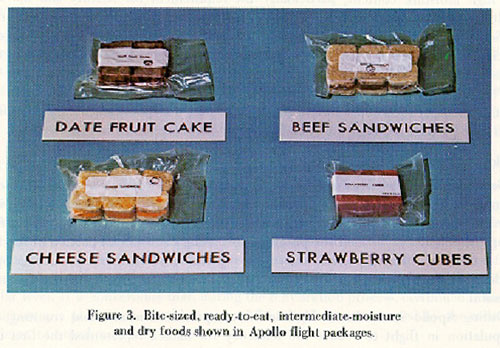
The issue of the New Yorker published just after the Moon landing is worth a look: much of the Talk of the Town section is devoted to the landing and there’s also a Letter from the Space Center. (Subscribers only.)
The main NASA site has an interactive feature to explore the landing site and Eagle (Eagle was the name of the lunar module).
Finally, there’s still some good stuff to be had on the old telly on Monday. The History Channel has As It Happened: Man on the Moon at 8pm ET:
This special takes viewers back to July 1969 to experience the actual CBS News/Walter Cronkite coverage of man’s first lunar landing. Using minimal editing and leaving the original footage untouched viewers will feel as if they are watching the CBS coverage in July of 1969. While today we know the outcome of Apollo 11’s mission it was not a given then. This will become evident watching Walter Cronkite and his colleagues as they watch the historic lunar mission unfold before them.
and Moonshot, a two-hour documentary about Apollo 11, at 9pm ET. Turner Classic Movies is airing a bunch of Moon-related movies all day, including A Trip to the Moon (a 12-minute film from 1902) at 8pm ET and the excellent For All Mankind (newly out on Criterion Blu-ray) at 8:15pm ET. The Discovery Channel has When We Left the Earth, a one-hour documentary on the mission, at 10pm ET. If none of that tickles your fancy, try episode 6 of the excellent From the Earth to the Moon (available for the insanely low price of $12 on Amazon) or In the Shadow of the Moon on DVD.
[If you enjoyed this post, you should post it to Twitter.]
Update: Tom Wolfe, author of The Right Stuff, writes that landing on the Moon killed NASA.
Everybody, including Congress, was caught up in the adrenal rush of it all. But then, on the morning after, congressmen began to wonder about something that hadn’t dawned on them since Kennedy’s oration. What was this single combat stuff — they didn’t use the actual term — really all about? It had been a battle for morale at home and image abroad. Fine, O.K., we won, but it had no tactical military meaning whatsoever. And it had cost a fortune, $150 billion or so. And this business of sending a man to Mars and whatnot? Just more of the same, when you got right down to it. How laudable … how far-seeing … but why don’t we just do a Scarlett O’Hara and think about it tomorrow?
July Moon is a forthcoming documentary about some lost NASA tapes. Surely not these NASA tapes?
The computer source code that ran Apollo 11’s Command Module and Lunar Module has been released.
A recently discovered photo clearly shows Neil Armstrong’s face on the Moon through his visor.
He was the first man to walk on the moon, taking that one giant leap for mankind — yet most of the famous shots are of his fellow astronaut Buzz Aldrin, as it was Armstrong who manned the stills camera.
New Scientist overlaid the Apollo lunar excursion maps on top of cities in Google Earth. Neil and Buzz didn’t even leave Trafalgar Square on their trip to the Moon.
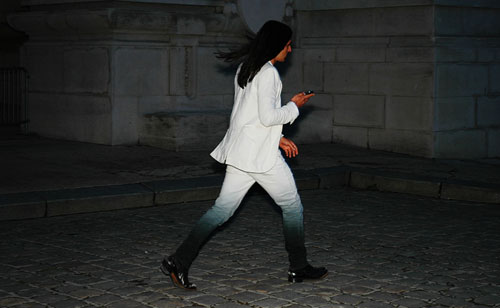
I love this photo from JAK & JIL BLOG. The lighting, the clothes, and the person wearing them are all perfect. Do click through to see it larger.
Photographer Paul Graham writes about what’s so easy:
It’s simply a way of recording what you see — point the camera at it, and press a button. How hard is that? And what’s more, in this digital age, its free — doesn’t even cost you the price of film. It’s so simple and basic, it’s ridiculous.
and difficult about photography:
It’s so difficult because it’s everywhere, every place, all the time, even right now. It’s the view of this pen in my hand as I write this, it’s an image of your hands holding this book, Drift your consciousness up and out of this text and see: it’s right there, across the room — there… and there. Then it’s gone. You didn’t photograph it, because you didn’t think it was worth it. And now it’s too late, that moment has evaporated.
Graham also describes photography as “an intuitive expression of liquid intelligence”, which seems an apt expression of creativity in general. (via noah kalina)
Light Test is a collection of light test snaps from photographers…most of them feature an assistant standing in for the actual subject.

Oddly compelling, perhaps because they’re so candid in relation to the finished product.
Update: Obama!
From Marcus Buck, imprints of demolished houses left on other houses.
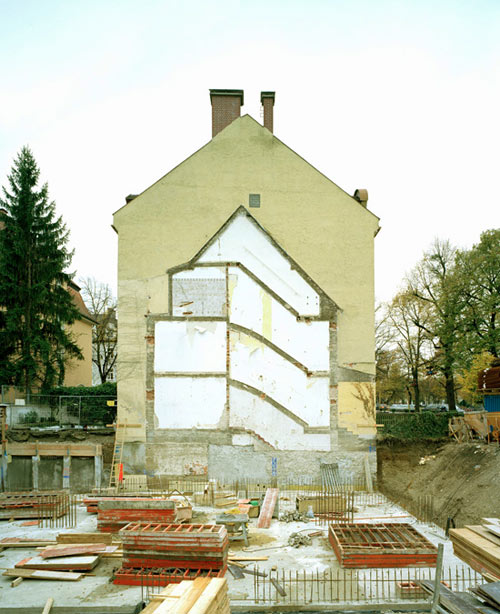
Photo is from Pruned. (via janelle)
Update: Medianeras, series of photos of “party walls” by José Antonio Millán. (via artifacting)
Rare mp3s of Weegee and Henri Cartier-Bresson talking about photography.
Below you can hear Weegee talk about picture-making. It’s interesting to hear his voice, which is one of those accents you don’t hear so much in New York anymore: part Austro-Hungarian immigrant by way of the Lower East Side and part Elmer Fudd. Peter Sellers based his accent in Dr. Strangelove on Weegee’s voice after Weegee visited Kubrick’s set one day.
Yep, that’s Strangelove, alright. (via conscientious)
This might be the creepiest thing on the internet today: The Puppet Show, photos of real children modified to look like puppets.
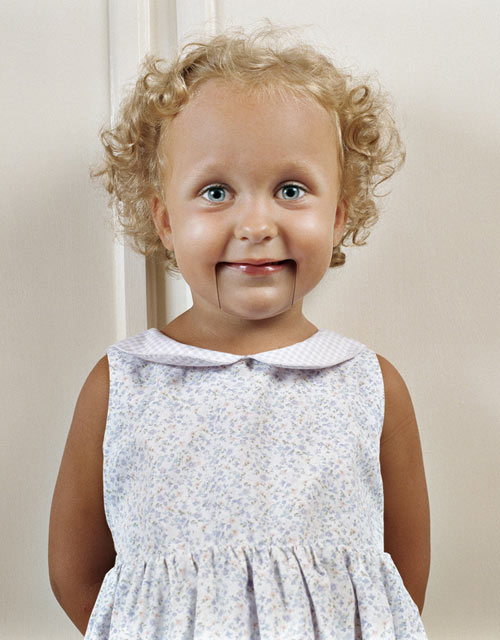
Waiting Topless (NSFW) is a audio slideshow about a pair of waitresses who worked at the Grand View Topless Coffee Shop in the small town of Vassalboro, Maine.
“Yes, I am a topless waitress, but I’m just a regular normal person in society,” Cunningham says. “I honestly don’t think in this economy right that there is a job out there that would pay roughly the same.”
The coffee shop recently burnt to the ground in a suspected arson.
The Wall Street Journal’s Photo Journal blog, the launch of which was inspired by The Big Picture, has posted exactly *zero* photos of what’s going on in Iran right now in their “Pictures of the Day” feature. That strikes me as odd. In contrast, The Big Picture has posted three big entries dedicated to the elections.
The Fallen Princesses project imagines Disney characters if their stories didn’t end happily ever after.
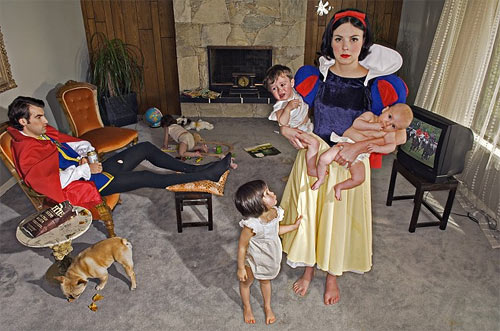
As a young girl, growing up abroad, I was not exposed to Fairy tales. These new discoveries lead to my fascination with the origins of Fairy tales. I explored the original brothers Grimm’s stories and found that they have very dark and sometimes gruesome aspects, many of which were changed by Disney. I began to imagine Disney’s perfect Princesses juxtaposed with real issues that were affecting women around me, such as illness, addiction and self-image issues.
Not so Charming. (via avenues)
You may remember Robbie Cooper’s projects Alter Ego (photos of gamers and their in-game avatars) and Immersion (kids filmed with an Interrotron while playing video games). Cooper’s new project is like Immersion, except with people watching porn. The video stills can be found in the July issue of Wallpaper but an 18-minute video is available on their web site.
In a film of startling power and unsettling intimacy — produced exclusively for wallpaper.com — video artist and photographer Robbie Cooper shoots back at active porn aficionados lost in ecstatic release and hears how their passion developed. Be aware that this is not easy titillation and some of you may find the footage shocking. But the film does throw up any number of questions about voyeurism and exhibitionism and makes clear the incredible nakedness of the solo sex act.
NSFW because it turns out that watching people watching porn at the office is no easier to explain to your boss/co-workers than actually watching porn at the office.

Inspired by Carl Fredricksen’s house in Up, which was holding up construction of a massive building complex, deputydog uncovers some more such houses, which are actually called nail houses.
Another nail house is actually a nail church. Citicorp Center was built without corner columns to accommodate St. Peter’s Church, which occupied one corner of the block on which the skyscraper was built. The engineer who built Citicorp Center made a mistake related to the church’s accommodation and famously corrected it after the building was built.
Update: The original link is dead, but In Focus has collected 20+ photos of nail houses in China, where development is happening quickly.
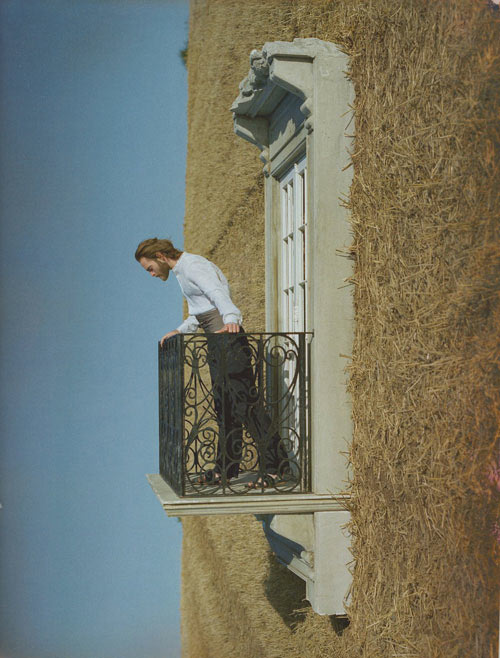
Tim Walker for Hermes. (via andrea inspired)
Update: Walker likely took his inspiration from Philippe Ramette.
The NY Times Lens blog, which has been really good right from the start, has a great story today about the photographers who took the pictures of the man in the white shirt staring down the tanks in Tiananmen twenty years ago.
As the tanks neared the Beijing Hotel, the lone young man walked toward the middle of the avenue waving his jacket and shopping bag to stop the tanks. I kept shooting in anticipation of what I felt was his certain doom. But to my amazement, the lead tank stopped, then tried to move around him. But the young man cut it off again. Finally, the PSB (Public Security Bureau) grabbed him and ran away with him. Stuart and I looked at each other somewhat in disbelief at what we had just seen and photographed.
I think his action captured peoples’ hearts everywhere, and when the moment came, his character defined the moment, rather than the moment defining him. He made the image. I was just one of the photographers. And I felt honored to be there.
Update: The Lens story prompted photographer Terril Jones to share a previously unpublished photo he’d taken of the tank man from a unique angle.
Update: From Lawyers, Guns, and Money:
The thing is, Tank Commander is far more dangerous than Tank Man. Tank Man can simply be shot; most seem to believe that Tank Man was later executed, far out of sight of the international media. The regime survives if Tank Man dies, even if the death of Tank Man isn’t the optimal outcome. The regime dies, however, if Tank Commander refuses to run over Tank Man. Eisenstein used the Odessa Steps to demonstrate the corruption of the Czarist regime, but the regime didn’t die until the soldiers refused to shoot the demonstrators. The successor regime didn’t die until Boris Yeltsin climbed on a tank in August 1991. While there’s some mystery as to the fate of Tank Man, I don’t doubt that the CCP found Tank Commander and put a bullet in the back of his head at the first opportunity.
For his The Girl Studies project, Charlie White paired photographs of two groups of people becoming women in very different ways: teen girls and adult male-to-female transsexuals.
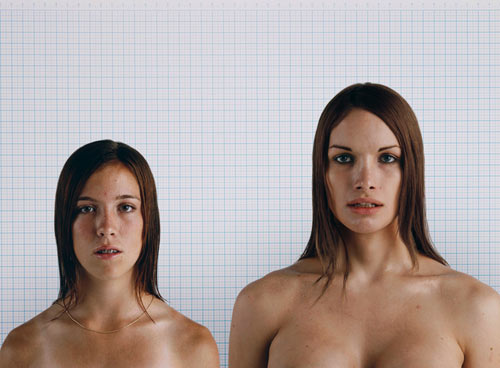
In the images in White’s series, both figures are blossoming into womanhood, though each along a different path. As observers, however, we have been taught to view the subjects in much the same way: with sheer terror.
These are fascinating. (via bygone bureau)
BLDGBLOG has an interview with photographer Richard Mosse about his new project called Breach. Mosse went to Iraq and photographed several of Saddam’s old palaces, many of which are occupied by American soliders living in improvised barracks.
It was extraordinary how some of the palace interiors had been transformed to accommodate the soldiers. Troops scurried beneath vaulted ceilings and glittering faux-crystal chandeliers. Lofty marble columns towered over rat runs between hastily constructed chipboard cubicles. Obama’s face beamed out of televisions overlooking the freezers and microwaves of provisional canteen spaces.
Update: Flavorwire has another interview with Mosse about these images.
Art Wolfe details the process he went through to get just the right photo of some Chinese fishermen. There were many false starts.
By the time I was ready for the next shot, the darkening evening sky balanced the light somewhat. A 16mm focal length endowed the image with the depth I wanted and, combined with an f16 aperture, ideal depth of field. Waning light necessitated a one to two second exposure. Although blurred moving birds ruined most of the shots, they blocked direct light from the lanterns. I was making progress.
Perhaps even more interesting that Wolfe’s process is the fishing method employed by his subjects; they use birds, not nets or poles:
For centuries fishermen on the Li River of Southern China have partnered with cormorants to catch fish. Each fisherman has a complement of half a dozen or so trained birds. The light of a lantern attracts the fish, and the cormorants return to the boat, fish in beak. They can’t swallow them because the fisherman fix a band around their necks, but they eventually get their share.
(via penmachine)
Stay Connected